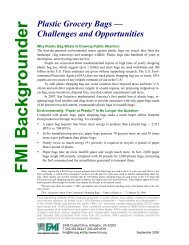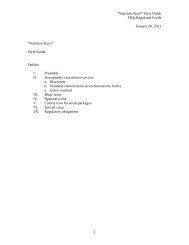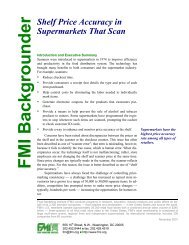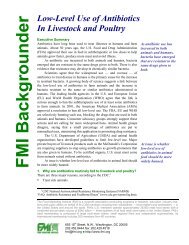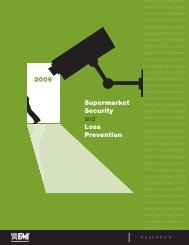Consumer Shopping Habits for Wellness and Environmentally ...
Consumer Shopping Habits for Wellness and Environmentally ...
Consumer Shopping Habits for Wellness and Environmentally ...
Create successful ePaper yourself
Turn your PDF publications into a flip-book with our unique Google optimized e-Paper software.
Displays<br />
Temporary displays made of flimsy <strong>and</strong>/or inexpensive materials tend to suffer<br />
visible wear, <strong>and</strong> generally look ―cheap‖ to consumers. H+W-oriented spaces are<br />
greatly enhanced by the use of permanent displays utilizing more durable materials<br />
such as wood <strong>and</strong> (non wire-like) metals. Natural materials are best.<br />
Permanence here is also important, in that display spaces should be dedicated.<br />
Temporary displays often violate layout lines (e.g. prominently projecting into an<br />
aisle from an otherwise flat shelf) <strong>and</strong>/or appear in seemingly r<strong>and</strong>om spaces,<br />
serving as obstacles to shoppers.<br />
Flooring<br />
Traditional tile flooring is generally a thing of the past. Often those tiles are difficult<br />
to make look clean regardless of scrubbing or polishing. More contemporary<br />
floorings such as wood or lacquered concrete convey far more positive impressions<br />
to shoppers, as well as tone down the sometimes ―harsh‖ visual feel of tile flooring<br />
in stark shades (e.g. white tile that reflects overhead lighting).<br />
Lighting<br />
Industrial <strong>and</strong>/or florescent lighting fixtures are often ―bright white‖ in their spectrum<br />
<strong>and</strong> lend retail spaces a more ―institutional‖ appearance. Using softer, often indirect<br />
lighting increases the level of felt elegance in a store or department.<br />
Color<br />
Color scheme(s) should not include significant amounts of bright, highly saturated<br />
primary colors, which often produce childlike or cartoonish looks when used<br />
extensively.<br />
As a final note, consistency is critical across the store design elements. Combinations of several<br />
different materials, color schemes, displays, et cetera tend to leave consumers with a feeling that a<br />
store was designed <strong>and</strong> assembled at different times, in a perhaps r<strong>and</strong>om fashion. In contrast,<br />
consumers react very positively to stores that have the appearance of design that is coordinated<br />
across departments <strong>and</strong> various design elements.<br />
The following are some examples of ―best practices‖ when it comes to positive in-store aesthetics.<br />
166





